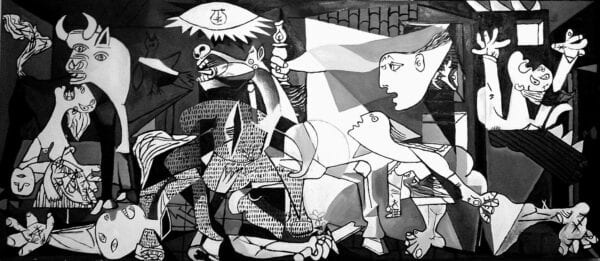I’ve been thinking about Picasso’s Guernica. During the last Art Laureate Conversation (8/31/2020) which was Robert Stackhouse’s and my first conversation on Political Art, I commented about the eye-shaped light found at the top center of the painting. That light illuminates the depicted atrocities from the bombing of the Basque town, Guernica, during the Spanish Civil War in 1937. The bombing was carried out by the air forces of Hitler’s Nazi Germany and the Italian Fascist regime.
The eye/light in its central position indicates the importance of making known the atrocities from the bombing. Picasso first learned of the bombing and the subsequent death and destruction from reading about it in the newspaper while he was living in Paris. Some say this is why there are newspaper-like images in the painting to pay homage the importance of the newspaper. Indeed, in the USA, journalism and the news in all its forms have reverently been referred to as the Fourth Estate. The other three being the Federal, Legislative, and the Judicial.
It is also the case that Picasso’s painting itself sheds light on this inhumane event so all the world would become aware. First to be aware of what occurred in Guernica itself, but also to be alerted to what Germany and Italy were capable of in the future. Europe and Great Britain were soon to find out.
Robert likes to tell the story, perhaps apocryphal, that a German officer was in Picasso’s studio in Paris and gesturing toward Guernica asked Picasso if he did that. Picasso, as the story goes, answered “No, you did.”
But back to the light. When I look at what the light is illuminating in the painting, I noticed that not all of the painting is illuminated. So, as I read it, there are still atrocities that have happened, that are happening, and that will happen of which we are not aware. Picasso was able to illuminate that of which he knew, but he was well aware that there was much he did not know.
This is where the question from Mark (I do not know his last name) asked during our Art Laureate Conversation comes in. He asked if it was the responsibility of an artist to make political art especially in times as these. Was it, for example, Picasso’s responsibility to paint Guernica?
I would like to answer “yes,” and I think I did the evening of our Art Laureate Conversation, but now in retrospect I would say “no.”
I would say that Picasso when he painted Guernica or Goya when he painted The 3rd of May 1808 (according to Wikipedia, also known as El tres de mayo de 1808 en Madrid or Los fusilamientos de la montaña del Príncipe Pío, or Los fusilamientos del tres de mayo) were not doing it out of responsibility, but out of passion and out of outrage. They painted those paintings because, at that time, they could not do otherwise. The best art and, for that matter, the best human actions happen because that person cannot do otherwise. Art and actions spring from who we are.
Few of us will ever paint a Guernica or a 3rd of May, but we do what we do. If we are true to ourselves and listen, then we need to trust that the art we make will make a difference. Here is where responsibility comes in. We are, in some respects, responsible for the difference our art makes.
Art On!





